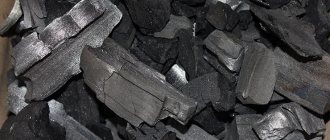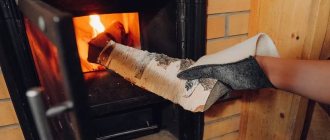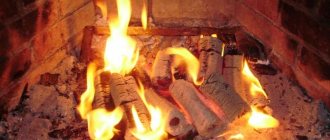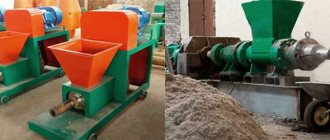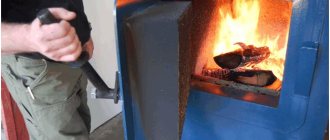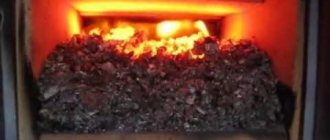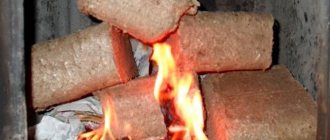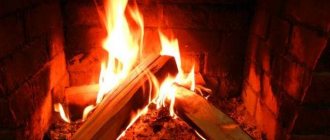Fuel briquettes are a modern alternative to conventional firewood or coal. They are compressed waste from the woodworking industry: sawdust, chips, shavings. Some types of briquette fuel are made from straw, sunflower husks, pine needles and other similar materials. The crushed waste is dried and pressed into a form convenient for use. Otherwise they are called Eurowood, since they were originally developed in Germany. This type of fuel has high potential and can completely replace firewood.
What is better - firewood or fuel briquettes?
Now briquette fuel, or pellets, is quickly gaining popularity among owners of cottages, dachas, and country houses. And this is not surprising, because, unlike ordinary firewood, briquettes do not require splitting, and during the combustion process they do not produce acrid smoke, ash and dirt. In addition, the efficiency of briquette fuel is five times greater than that of traditional fuels.
Briquette fuel burns twice as long as regular logs. This is preferable for stoves with a long burning period. And in stoves or fireplaces with a fast combustion cycle, it is better to use wood, given their high heat output.
How to replace firewood when using a fireplace: 5 options
Most likely, you have a popularized opinion about the fireplace, which is imposed by books, pictures and films. Tongues of red-orange flame embrace the firewood in the open portal of the fireplace, the romantic crackle of burning wood. Such a fireplace looks very beautiful, but its functionality leaves much to be desired, because it can only heat one room. Setting up and maintaining such a fireplace is also quite difficult. But its performance can be significantly affected by the correct selection of fuel.
Which fuel is more profitable?
When choosing between briquettes and regular firewood, you should take into account the cost of these types of fuel.
For example, in Moscow, one cubic meter of briquette fuel varies within 6 thousand rubles, and for the same volume of wood you will have to pay approximately 3 thousand rubles. However, in the total mass of logs, as a rule, about a third can be low-quality, raw products. Considering that the heat transfer from burning logs is much lower than from briquettes, the benefits of using briquette fuel are obvious.
These calculations are approximate and are not suitable, for example, for regions where a truckload of firewood can be bought for very little money.
Preparation of firewood.
December is the most favorable month for collecting firewood. After all, at this time all the trees are sleeping (except for pines), the sap flow in them is very slow, which means the firewood will dry well. In addition, in winter it is easier to transport firewood from the forest. It is especially recommended to prepare alder firewood in winter, since alder is difficult to access during the rest of the year due to the fact that this tree grows mainly on swampy soils.
Knowing the features of your stove, you can choose which firewood is best suited for it, the main thing is that it warms and fills the house with warmth.
Which fuel briquettes burn better and last longer?
Euro firewood differs from each other only in shape and material of manufacture. Wood briquettes made from sawdust burn better and longer than others, if we talk about the material used.
There are three main forms of fuel briquettes, which will also have different calorific values:
- Roof - produced in the form of bricks, have a small size and low density - 0.7 - 0.8 grams per cubic centimeter. They are easy to use and have high calorific value. This is an average price-quality ratio;
- Pini-kei - the cross-sectional shape resembles a square or hexagon with a through hole for better air movement and combustion. They have a high density of 1.08 to 1.4 grams per cubic centimeter. Such products are characterized by special surface firing, due to which these briquettes are more durable, and they burn longer and better. Pini-key briquettes are number one among analogues;
- Nestro is produced in the shape of a cylinder and has an average density of 1 to 1.15 grams per cubic centimeter. Such briquettes have a low cost and, accordingly, burn out faster than the analogues described above;
Storage rules
Manufacturers recommend storing fuel briquettes under certain conditions:
- temperature from 5 to 400C;
- relative air humidity 40-80%;
- away from sources of open flame and away from direct sunlight.
Briquettes must be reliably protected from acid-base environments and moisture. The shelf life of fuel briquettes is from 3 to 5 years.
What are briquettes for heating made of?
When choosing briquette fuel, it is important to pay attention to the material used to make the product. In the production of pellets, waste from the wood processing industry is most often used. However, products made using waste from plywood mills should be avoided. Such briquettes may contain formaldehyde resins and their combustion cannot be considered environmentally safe. Agriculture also has a huge supply of processed products, which successfully serve as raw materials for the production of pellets.
The raw materials used affect not only the final cost of the product, but also the calorific value of the briquette, the amount of soot emitted, ash content, as well as the quality and completeness of combustion.
Briquette composition
- Wood shavings. Briquettes made from it have a good specific heat of combustion, but leave behind quite a lot of ash, similar to the wood from which they are made;
- Sunflower husk. Such briquettes provide the highest calorific value due to the oil they contain, which has good energy potential. However, it must be taken into account that briquettes made from sunflower seeds more intensively pollute the chimney with soot;
- Straw. It is considered a good raw material for pellets because it has low cost, good heat transfer and average ash content;
- Tyrsa. Briquettes made from this perennial plant burn well. The specific heat of their combustion is higher than that of straw pellets, and they leave less ash;
- Rice husk. The most budget-friendly option for producing fuel briquettes, which have low calorific value and high ash content. But after processing rice, a lot of husk remains, so this type of raw material should be used and is an alternative.
Technology
The most suitable raw material for the production of peat briquettes is low-grade peat, which does not contain any by-products and consists of fine particles.
Fuel bricks from such low-lying peat bog are high-calorie and dense, dark brown, almost black in color.
It is important to remember: peat fuel briquettes are used exclusively for boilers operating on solid fuel.
The technology for producing peat fuel is quite simple and is as follows:
- peat chips are extracted by milling the upper layer of caustobiolite;
- using drying and turning, the crushed raw materials are brought to the required moisture content;
- Then the dried products are stored in piles.
The next production stage is drying the semi-finished product to 9-12 percent humidity. Then the raw materials are separated and sent to the press for briquetting. High pressure and temperature conditions of 200-350 degrees Celsius contribute to the melting of workpieces, increasing their strength.
The result is a peat briquette with certain parameters:
- briquette size – 150 x 70 x 60 mm;
- mass fraction of sulfur – within 0.2%;
- content of ash impurities – no more than 15%;
- standard humidity – within 18%;
- calorific value – from 4500 Kcal/kg.
This briquetted fuel is popular among private owners and is used in furnaces and boilers with controlled air supply. And the ash obtained from the combustion of peat briquettes, according to reviews from amateur gardeners, is an ideal mineral fertilizer with a high content of potassium and phosphorus.
You may be interested in an article on how to connect a gas boiler. You can read about the boiler room in a private house in this article.
In addition to the milling method of extracting peat raw materials, there is also a less expensive and simple method for harvesting sod peat. With the help of special attachments to the tractor, compaction takes place in areas where high-moor peat is being developed.
The completed briquettes are extruded directly onto the field and dried under natural conditions. This type of briquette is called “peat firewood”. The disadvantages of peat fields include low heat transfer and variability of consumer criteria. In most cases, boiler houses operating on solid fuel use peat firewood.
Fuel briquettes - pros and cons
What are the advantages of fuel briquettes:
- Ease of storage - Euro firewood is stacked in even stacks, thanks to the same shape;
- Longer burning time compared to conventional firewood;
- Uniform and soft burning, more like smoldering, without crackling or shooting embers;
- Low labor costs for further cleaning and maintenance of the furnace due to the release of less ash and soot;
- Environmentally friendly use - briquettes burn 97-99%, almost without forming resins;
The use of fuel briquettes does not come without certain disadvantages:
- Briquette fuel has a limited shelf life and use. As a rule, it ranges from one year to three years from the date of manufacture;
- The cost of purchasing pellets may be more significant than purchasing firewood. It all depends on the manufacturer or region of residence;
- Some types of briquettes have low moisture resistance;
Coal
There are several types of coal, but for heating a house it is better to use anthracite - the so-called stone or brown coal. With minimal consumption, it has maximum heat transfer, long and uniform combustion, and emits a small amount of harmful combustion products. However, such coal is quite expensive, and it also takes a long time to ignite. Therefore, preference is increasingly given to long-flame coals, suitable for any solid fuel boilers.
When burning coal, the temperature inside the stove is much higher than when burning wood, the walls of the firebox must be reinforced with thicker sheets
The disadvantages of coal heating include:
- — without firewood you won’t be able to light coal;
- — the need to frequently add fuel, additional costs for waste disposal;
- - coal dust.
When burning coal, a closed chimney damper saves heat. Be sure to keep an eye on the flame; when a blue color appears, open the damper slightly to prevent the room from filling with carbon monoxide.
How to properly heat a stove with briquettes
When igniting the stove and firing it, you should adhere to the following recommendations. First, the stove must be cleaned of the remnants of the previous combustion. Then a small amount of paper or dry wood chips is placed on the grate. Briquettes are laid loosely on top of the paper if quick combustion is needed. If prolonged burning is required, fuel briquettes should be placed closer to each other. After this, you need to set fire to the paper or wood chips. The most convenient way to do this is with a gas burner. Then you should wait until at least one briquette begins to smolder. And only after this you need to close the stove vent. It is important here to prevent rapid combustion; the briquettes should smolder. Thus, their potential will be revealed gradually and evenly.
A little advice - to reduce soot settling in the chimney, you need to throw a pinch of salt on the pellets or firewood before lighting.
Summarizing the above, we can say that fuel briquettes are an excellent environmentally friendly replacement for firewood and coal. To choose quality products, when purchasing, you should read the test report, which will indicate the main characteristics of the briquette fuel.
Biofireplace
Biofireplace belongs to modern types of heating systems.
The peculiarity of this type is that it does not need a chimney or any hood, even with a real flame in the firebox. The main part of the biofireplace is a block into which ethanol is poured. Such fuel does not emit any soot or soot during combustion. During combustion, there are no unpleasant odors due to the fact that carbon dioxide and water vapor are combustion products.
Such fireplaces are used only for decorative purposes, so their productivity is zero.

